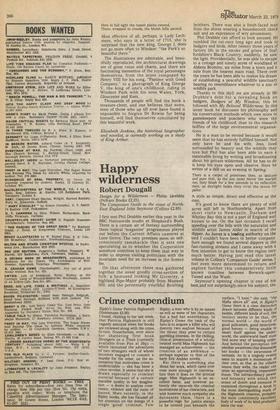Crime compendium
Ripley's Game Patricia Highsmith (Heinemann £2.50) I found, chatting to her last week, that Patricia Highsmith is still vaguely annoyed when her books are reviewed along with the crime fiction. Nonetheless, ever since her shattering first book Strangers on a Train (currently available from Pan at 30p) which recounted the adventures .of two strangers each of whom becomes engaged to commit a murder for the other, on the assumption that motiveless crime is undetectable she has been a crime novelist. It seems that she is drawn especially to criminal material because of a certain macabre quality in her imagination a desire to analyse conscience, violence and the roots of hatred. More recently, in the Ripley books, she has focused all her attention on the doings of a single 'good' criminal, Tom Ripley, a man who is by no means as evil as some of her characters, but a bad hat nonetheless. In Ripley's Game the task of the hero is to acquire a killer who will destroy two mafiosi because of the threat they pose to certain gambling interests. In the chilling, clinical presentation of a wholly twisted world Miss Highsmith has managed an achievement the creation of an ambience perhaps superior to that of the early Eric Ambler novels.
But there is something else about her work, which came over even more strongly in conversation than it does on the printed page. Miss Highsmith is an excellent hater, and however patiently she unravels the criminal motivations of her characters, and with however much sympathy she delineates them, there is a powerful rage for justice always to be sensed just beneath the
surface. "I hate," she said, "the Mafia above all" and, in Ripley's Game there is a clear distinction drawn between different kinds of baddie, different kinds of evil. Her instinct seems to be that, the normal world the world of good policemen, good detectives, good heroes being unable to assert itself against the underworld, the underworld itself must find some way of keeping order. And behind the perception lies another awareness that dominates her books the awareness of nemesis. As in a tragedy events seem to acquire a momentum of their own, so that as the villains weave their webs, the reader can sense an approaching, impersonal doom. The extraordinary powe.r and intensity with which this sense of doom and nemesis is sustained throughout a book Is the most distingushing mark of the Highsmith creation, probablY the most consistently excellent body of work of its kind produced since the war.


































 Previous page
Previous page